| |
|
|
Die
Oase Nukheila / Merga (NW-Sudan / Darfur) und Umgebung:
Nukheila / Merga oasis of N-Sudan / Darfur, and surroundings:
Location: 19° 03'N/26°19'E |
| |
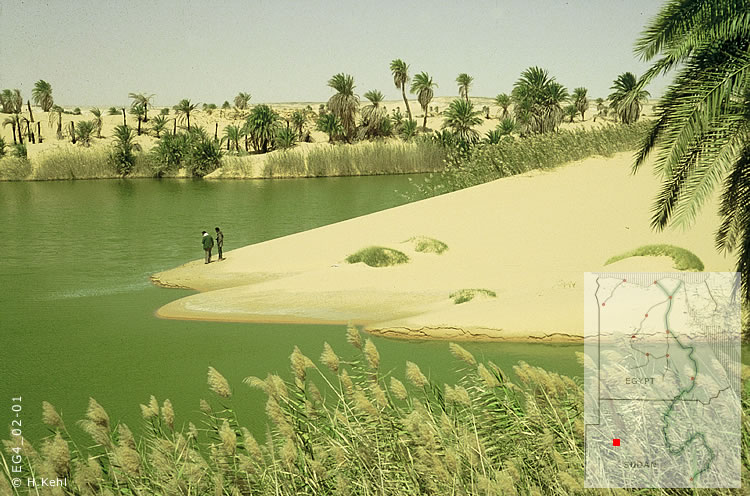 |
| |
 Abb.
D2-21/01 (oben): Abb.
D2-21/01 (oben):
Östliche Sahara, NW-Sudan (Darfur), die Oase Nukheila
(Merga)
Grosse und dichte Bestände von Phragmites
australis (Cav.) Trin. ex Steud. charakterisieren den
Uferbereich, gefolgt von Phoenix dactylifera, welche
niemals im Wasser steht. Auf der frischen Dünenzunge mit
geringeren Salzgehalten stehen vereinzelt Horste von Sporobolus
spicatus (Vahl) Kunth. Das Seewasser hat extrem hohe
Salzgehalte durch Verdunstung. Nach aussen ordnet sich die floristische
Zusammensetzung der Vegetation ringförmig an und ist abhängig
vom Gradienten des Salzgehaltes in den Böden. |
| |
E-Sahara,
NW-Sudan (Darfur), Nukheila (Merga) oasis;
A large belt of Phragmites
australis (Cav.) Trin. ex Steud. characterise the
inner margin of the very salty lake. Phoenix dactylifera is
not growing in shallow water, but at dampy places. Sporobolus
spicatus (Vahl) Kunth. grows very rare on dunes near
the lake, if the soils are not too salty. The floristical composition
of the vegetation has a ring-shaped character as a result of
the soil salinity gradient from the center of the oasis to the
outer margin. |
| |
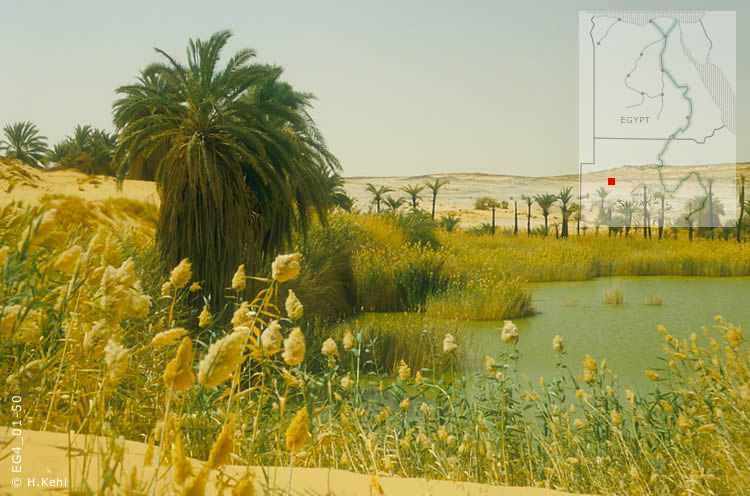 |
| |
 Abb.
D2-21/02 (oben): Abb.
D2-21/02 (oben):
Östliche Sahara, NW-Sudan (Darfur), die Oase Nukheila
(Merga)
Gleiche Situation wie oben: Westrand des Sees. |
| |
E-Sahara,
NW-Sudan (Darfur), Nukheila (Merga) oasis;
Same situation as above: western edge of the lake |
| |
-
Kehl, H. (1987) Zonation and establishment of vegetation
in selected uninhabited Egyptian and Sudanese oases.- Catena
14: 275-290.
 Zusammenfassung
/ Abstract -
Gesamter
Artikel / Full article :
Zusammenfassung
/ Abstract -
Gesamter
Artikel / Full article :
 [2MB
- 15 pages]
[2MB
- 15 pages]
|
| |
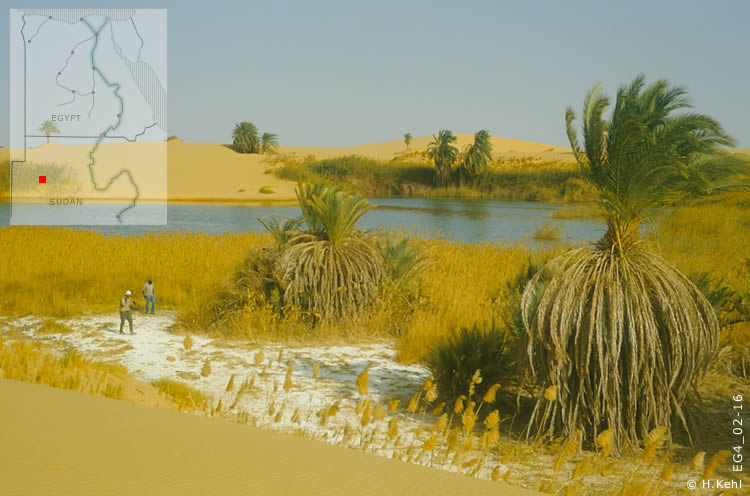 |
| |
 Abb.
D2-21/03 (oben): Abb.
D2-21/03 (oben):
'Alte' ufernahe und flache Zonen tragen eine dicke Salzkruste.
Im Hintergrund reicht eine Düne bereits in den See und
hat die Phragmites-Bestände unter sich begraben. |
| |
E-Sahara,
NW-Sudan (Darfur), Nukheila (Merga) oasis;
White salt crusts are very common on shallow littoral areas. |
| |
| |
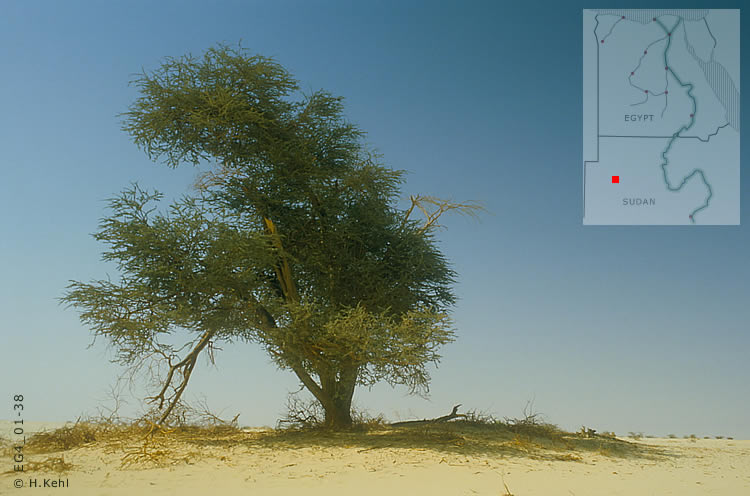 |
| |
 Abb.
D2-21/04 (oben): Abb.
D2-21/04 (oben):
Östliche Sahara, NW-Sudan (Darfur), die Oase Nukheila
(Merga)
Acacia tortilis
ssp. raddiana (Savi.) Brenan, findet sich ausschliesslich
im äusseren Bereich der Oase, häufig zusammen mit
der eher strauchartigen Acacia
ehrenbergiana Hayne,
welche in der Regel in ihrem unmittelbaren Wuchsbereich Sand
akkumuliert (vgl. phytogenetic
sand mounds / hummocks and hillocks). |
| |
E-Sahara,
NW-Sudan (Darfur), Nukheila (Merga) oasis;
Acacia tortilis ssp. raddiana (Savi.) Brenan is growing
only at the outer margin of the oasis, often together with Acacia
ehrenbergiana Hayne, (not as a tree, but forming phytogenetic
sandmounds / hummocks and hillocks). |
| |
| |
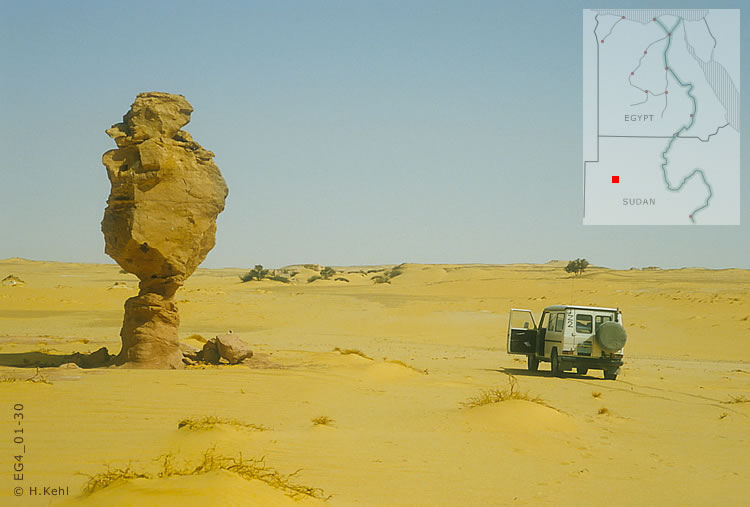 |
| |
 Abb.
D2-21/05 (oben): Abb.
D2-21/05 (oben):
Östliche Sahara, NW-Sudan (Darfur), bei der
Oase Nukheila (Merga)
Der als 'Sandstein-Pilz' bekannte Felsen als 'Zeugenberg'.
Im Hintergrund Akazien, Tamarisken und im Vordergrund
tote Cornulaca monocantha. |
| |
E-Sahara,
NW-Sudan (Darfur), near Nukheila (Merga) oasis;
Single sandstone called 'mushroom' as an erosional outlier.
In the background Acacia, Tamarix and in front remnants
of dead Cornulaca monocantha. |
| |
| |
|
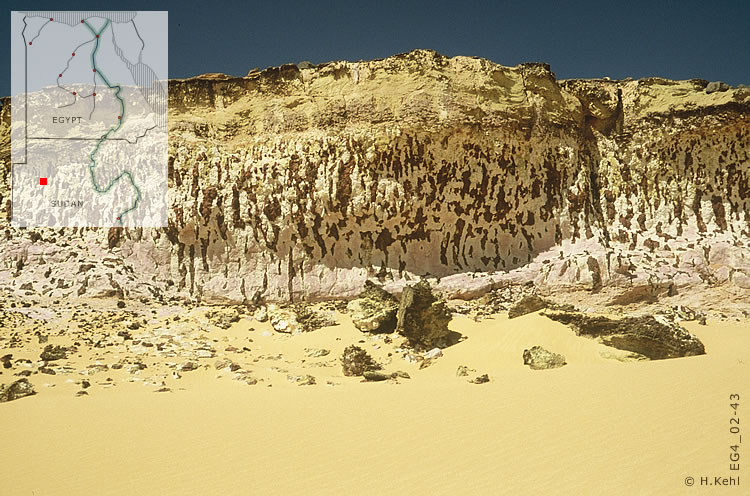
|
| |
 Abb.
D2-21/06 (oben): Abb.
D2-21/06 (oben):
Östliche Sahara, NW-Sudan (Darfur), bei der Oase
Nukheila (Merga)
Marmorierter Tonstein (siehe Lit.angabe unten!), verursacht
durch ehemalige Wurzeln. Paläoboden mit Eisenoxid-Einlagerungen
bzw. -Verlagerungen, Wurzelspuren und Bioturbationen |
| |
E-Sahara,
NW-Sudan (Darfur), near Nukheila (Merga) oasis
Palaeo-Soil: Leached banded sandstone with traces of roots
and bioturbation |
| |
|
 Literatur/e:
Literatur/e:
- Böttcher,
R. (1982) Die Abu Ballas Formation (Lingula Shale)
(Apt?) der Nubischen Gruppe Südwest-Ägyptens.
Eine Beschreibung der Formation unter besonderer Berücksichtigung
der Paläontologie. - Berliner geowiss. Abh.,
(A),39, 145 pp., Berlin.
- Hendriks,
F. & H. Kallenbach (1986)
The offshore to backshore environments of the Abu
Ballas Formation of the SE Dakhla Basin (Western Desert,
Egypt).- International Journal of Earth Sciences,
Vol. 75 (2): 445-460.
|
| |
 |
| |
|
Copyright
© H. Kehl
Ehemals TU-Berlin - Institut für Ökologie
|
| |



|
| |
|
|
|
| |
| |
| |
| |
|
|
|